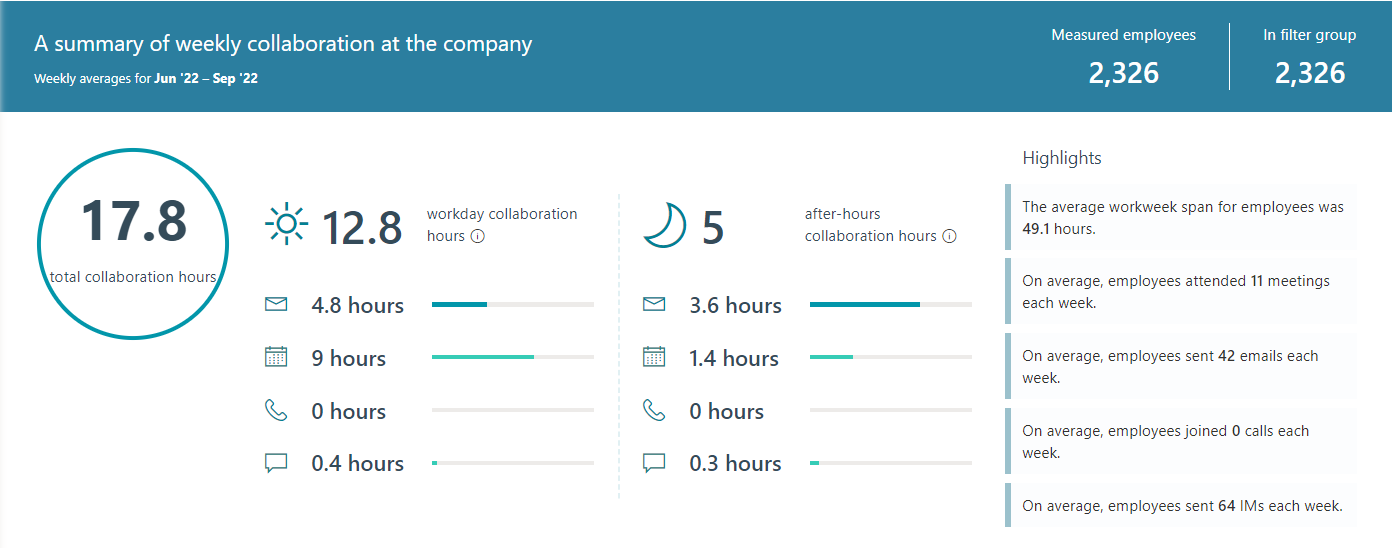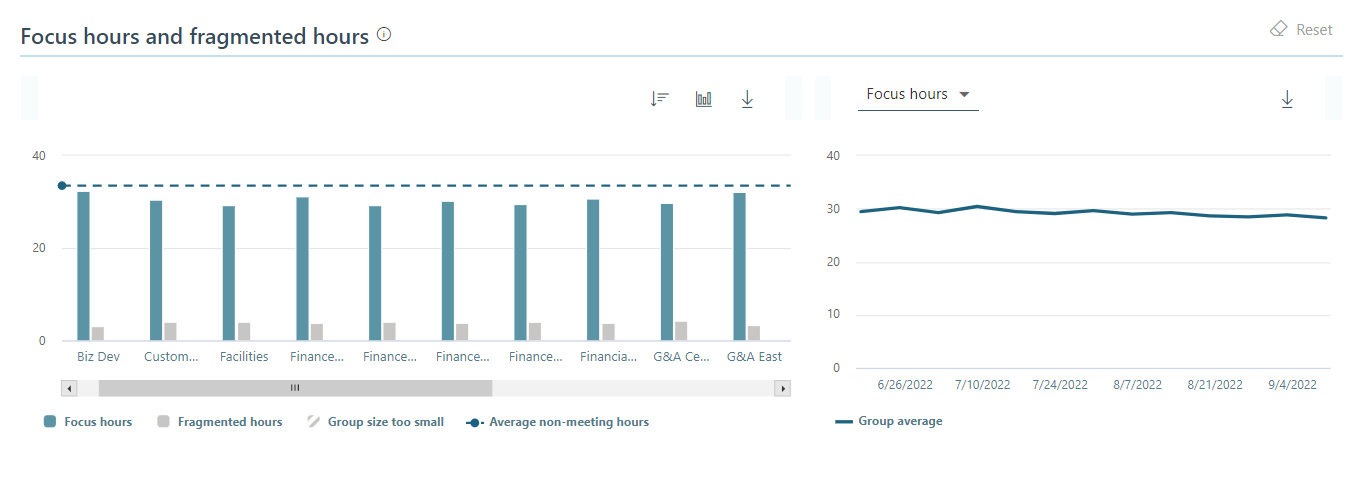Week in the life
Important
This article is for the legacy Workplace Analytics app and does not reflect functionality available on the updated Viva Insights platform. Access current documentation for Viva Insights advanced insights here: advanced insights documentation.
Week in the life summarizes weekly collaboration in the organization. You can use these metrics as a starting point to explore more in-depth metrics and reports. Employees who sent at least one email or instant message during a week are considered active and are included in the data for the weeks they are active.

Access to Week in the life
You can open Week in the life(if that link doesn't work, try this link instead) to view it in Viva Insights.
All collaboration hours
All collaboration hours shows the number of hours a person spent in meetings, emails, IMs, and calls with at least one other person, either internal or external, after deduplication of time due to overlapping activities (for example, calls during a meeting).

Why it's important
Meeting, email, call, and IM hours are the most basic components of collaboration. They help quantify the collaboration volume and patterns within a company, potentially highlighting an under or overly collaborative culture.
Excess incoming email becomes a distraction from work focus and a source of employee stress, particularly if combined with many meetings. Too many hours in meetings reduces the time available to complete individual work tasks, which can lead to longer working hours and employee stress. Similarly, too many IMs and unscheduled calls can distract from the flow of work.
Viva Insights helps analysts identify high and low collaboration and its causes.
Common causes of high levels of collaboration
- Large meetings from an overly inclusive culture typically leaves all but a small minority of people actively engaged.
- Unnecessary attendees in meetings can result in unproductive collaboration time.
- Long meetings can potentially make it difficult to retain the focus of attendees unless they are well-designed small sessions.
- Recurring meetings may persist long after the value of the collaboration has been gained.
Common causes of low levels of collaboration
- Teams or organizations that operate in silos and don’t collaborate across the company.
- A company culture that does not promote collaborative behaviors and open working styles.
After-hours collaboration hours
After-hours collaboration hours shows the number of hours that a person spent outside of working hours in meetings, emails, IMs, and calls with at least one other person, either internal or external, after deduplication of time due to overlapping activities (for example, calls during a meeting). (Viva Insights uses 9 AM to 5 PM, Monday to Friday as the default for business hours.)

Why it's important
Different roles require different schedules, but monitoring after-hours activity can help identify employees who are at risk of getting overworked or have an unsustainable workload.
- Email and IMs sent after hours, particularly by managers, can generate overtime workload for the recipients, and can result in undue stress and poor work-life balance for employees who feel compelled to respond before the next standard workday.
- Too much after-hours activity also hampers productivity. Employees need time off to recharge and to produce new ideas and fresh insights.
- If a person consistently has after-hours collaboration, this can be an indicator of under-capacity in a group.
- Requiring a consistently high number of after-hours work from employees due to collaboration with other time zones creates a work-life imbalance and can lower employee satisfaction and productivity.
Internal only and external collaboration hours
Internal only collaboration hours are the number of hours a person spent in meetings, emailing, calling, and IM-ing only with people inside of the organization.
External collaboration hours are the number of hours a person spent in meetings emailing, calling, and IM-ing with at least one person external to the organization.

Why it's important
Who employees spend their time with is key to understanding if they are performing as expected in their role.
- Internal collaboration can be an indicator of the complexity of the processes employees must navigate to complete their work.
- External collaboration can be an indicator of external activity and relationships associated with various organizations in the company.
- Too much time spent with either an internal or external customer, partner, or vendor can indicate a problematic relationship, particularly if it extends over a long period.
Focus hours and fragmented hours
Focus hours are two or more consecutive hours in a person's calendar that do not contain a meeting within the company's set business hours.
Fragmented hours are non-scheduled business time periods that last less than two hours.

Why it's important
- Two-hour blocks of uninterrupted time are critical for a person to be able to focus and complete critical individual work.
- Short blocks of free time less than two hours might not provide enough time for an employee to focus on complex tasks.
- A low number of focus hours, particularly for independent contributors, suggests insufficient time to get work done.
- Performance can suffer as employees work longer hours to complete work, ultimately leading to potential for stress, burnout, and employee turnover.
- Low focus hours can also lead to poor collaboration behaviors such as multitasking during meetings.
Workweek span
Workweek span is the time between the person's first email or meeting and the last email or meeting in a day. (This is counted from Monday to Friday, with a minimum of four hours and a maximum of 16 hours per day.) If reported for the week, the metric is a sum for the week. If reported for the month, the metric is the weekly average.

Why it's important
Workweek span captures the span of time an employee spends in work-related activity during the work week. It provides an estimate for how many hours each week employees are engaged in work, whether they are in the office or not.